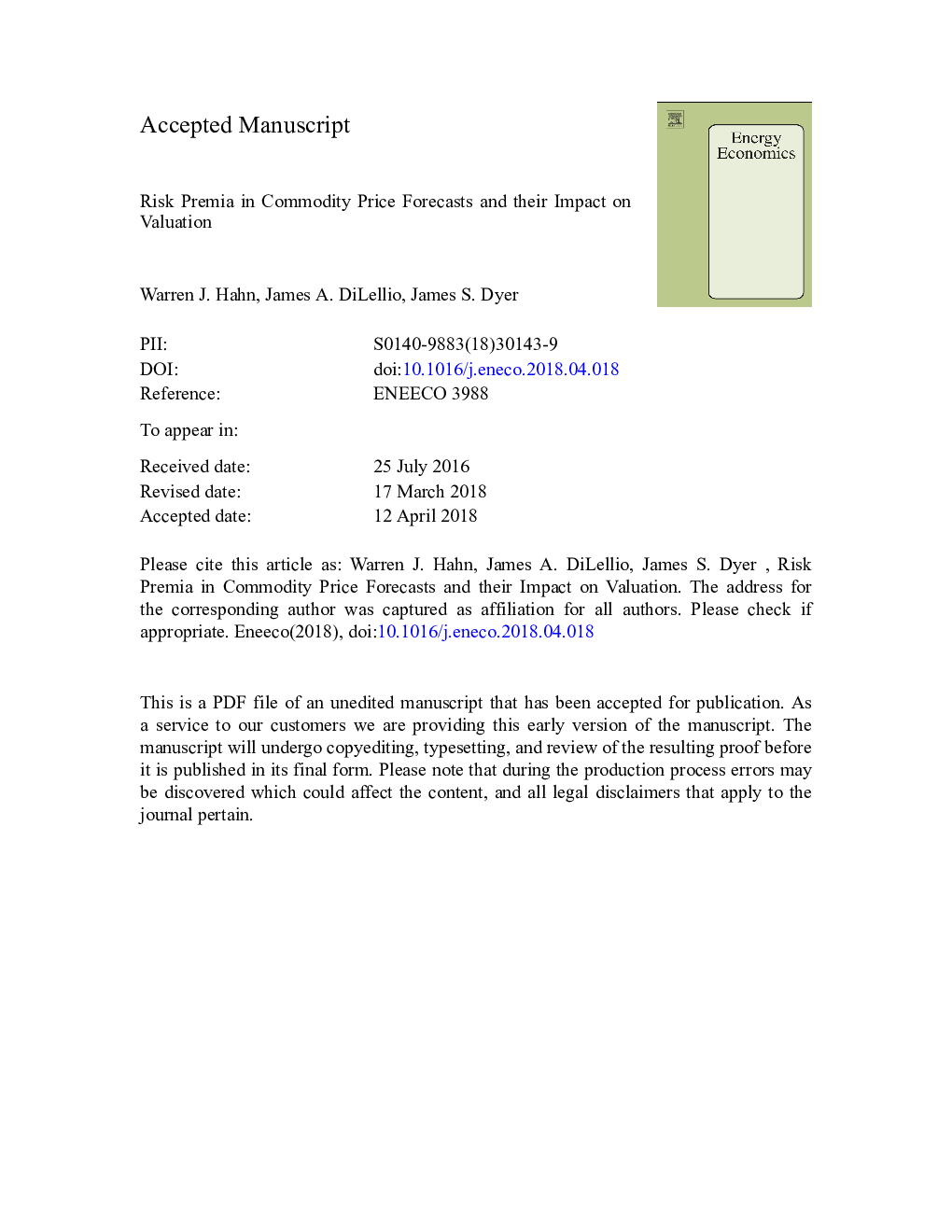| کد مقاله | کد نشریه | سال انتشار | مقاله انگلیسی | نسخه تمام متن |
|---|---|---|---|---|
| 7350578 | 1476691 | 2018 | 28 صفحه PDF | دانلود رایگان |
عنوان انگلیسی مقاله ISI
Risk premia in commodity price forecasts and their impact on valuation
ترجمه فارسی عنوان
مزایای ریسک در پیش بینی قیمت کالاها و تاثیر آنها در ارزیابی
دانلود مقاله + سفارش ترجمه
دانلود مقاله ISI انگلیسی
رایگان برای ایرانیان
کلمات کلیدی
ترجمه چکیده
مدل های ارزیابی قیمت کالاها نیازمند ورودی قیمت تصادفی است اگر ارزش انعطاف پذیری مدیریتی، مانند گزینه ای برای تعلیق سرمایه گذاری تا زمان بهینه و گزینه ای برای رها کردن پروژه، تخمین زده شود. نسخه خطرناکی از مدل قیمت تصادفی معمولا در کارهای دانشگاهی استفاده می شود؛ با این حال، مدل های تعدیل شده با ریسک از قیمت نقطه مورد انتظار اغلب در عمل استفاده می شود. این دو رویکرد با یک حق بیمه خطر مرتبط است که متأسفانه اغلب دشوار است. در این کار، ما از قیمت آتی گاز طبیعی در یک روش فیلتر کالمن با حداکثر احتمال برآورد پارامتر مدل قیمت تصادفی شوارتز و اسمیت (2000) استفاده می کنیم و سپس مدل قیمت گذاری دارایی را برای رسیدگی به عدم قطعیت بزرگ برآورد پارامترهای احتمال خطر . برای ارزیابی تاثیر مزایای ریسک و پارامترهای دیگر در مدل قیمت دو عامل در ارزیابی پروژه، ما مدل قیمت را به یک سرمایه اولیه اولیه شیل گاز، برای هر یک از موارد مرجع پایه و همچنین برای مواردی که گزینه های واقعی وجود دارد، اعمال می کنیم. برای تصمیم گیری بهینه زمان برای سرمایه گذاری یا رها کردن پروژه. با استفاده از این رویکرد، ما قادر به تعیین نرخ انحراف معیار ریسک پذیر شده است که با پیش بینی قیمت نقطه مورد استفاده قرار می گیرد، با توجه به مزایای ریسک مدل دو عامل، و همچنین ما در مورد تاثیر حق بیمه بر ارزش پروژه نسبت به پارامترهای دیگر مدل
موضوعات مرتبط
مهندسی و علوم پایه
مهندسی انرژی
انرژی (عمومی)
چکیده انگلیسی
Commodity price driven valuation models require a stochastic price input if the value of managerial flexibility, such as the option to defer investment until the optimal time and the option to abandon a project, is to be estimated. The risk-neutral version of the stochastic price model is typically used in academic work; however, risk-adjusted models of the expected spot price are often used in practice. These two approaches are connected by a risk premium which is unfortunately often difficult to estimate. In this work, we use natural gas futures prices in a Kalman filter approach with maximum likelihood estimation to parameterize the Schwartz and Smith (2000) stochastic price model, and then apply an asset pricing model to address the large uncertainty of the risk premia parameter estimates. To evaluate the impact of the risk premia and other parameters in the two-factor price model on project valuation, we apply the price model to a prototypical shale gas investment, both for a base reference case as well as for cases where there are real options to optimally time decisions to invest or to abandon the project. Using this approach, we are able to determine the implied risk-adjusted discount rate that would be used with the spot price forecast, given the two-factor model risk premia, and we also discuss the impact of the risk premia on project value relative to other model parameters.
ناشر
Database: Elsevier - ScienceDirect (ساینس دایرکت)
Journal: Energy Economics - Volume 72, May 2018, Pages 393-403
Journal: Energy Economics - Volume 72, May 2018, Pages 393-403
نویسندگان
Warren J. Hahn, James A. DiLellio, James S. Dyer,
